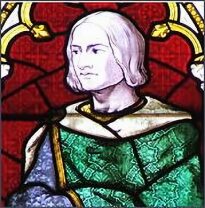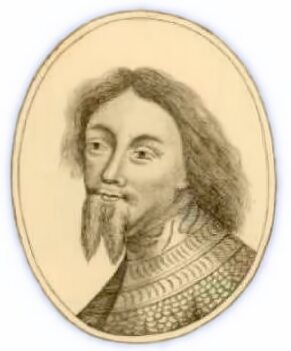Circa 20 July 1375 - 5 August 1415
Richard of Conisburgh, 3rd Earl of Cambridge was born circa 1375, at Conisbrough Castle, in Yorkshire, he was the second son of Edmund of Langley, 1st Duke of York, (fourth surviving son of Edward III) and Isabella of Castile, daughter of Pedro the Cruel of Castille and his mistress, Maria de Padilla. King Richard II stood as his godfather.
The couple had two other children, Edward (c. 1373), who became 2nd Duke of York and died at the battle of Agincourt (1415) and Constance (c. 1375), later Countess of Gloucester through her marriage to Thomas le Despencer, who was to become the great grandmother of Queen Anne Neville.
Richard of Conisburgh, 3rd Earl of Cambridge
Richard's mother, Isabella, indulged in an affair with King Richard II's half-brother, John Holland, 1st Duke of Exeter (died 1400), the son of Joan 'Fair Maid of Kent' by her first husband Thomas Holland, 1st Earl of Kent. It has been suggested that since he received no lands from his father, and received no mention in either his father's or his brother's wills, he may have been the child of his mother's affair with Holland. The fact that the Y DNA of Richard's grandson did not match that of the male line descendants of Henry Somerset, Duke of Beaufort reveal that somewhere in the generations there was a false paternal event in one of these lines.
Prior to her death on 23 December 1392, Richard's mother, Isabel, named King Richard II as her heir, requesting him to grant her younger son an annuity of 500 marks. The King honoured her request, paying Richard with an annuity of £100 on 3 February 1393, and made a further payment to Richard of £233 6s 8d on 16 March 1393. Richard II was deposed by his cousin Henry of Bolingbroke in 1399, who assumed the throne as King Henry IV, the first of the Lancastrian line of kings. Richard of Conisburgh's father, Edmund Duke of York was acting as regent at the time but deserted Richard's cause and went over to Bolingbroke, for which he received ample rewards. From April 1403 to October 1404 Richard commanded a force defending Herefordshire against Owain Glyndwr, who led a Welsh rebellion against the king. Richard was knighted by Henry IV on 26 June 1406 and soon afterwards he acted as escort for king Henry's daughter Philippa, who was to be married to Eric of Denmark. He sailed from Lynn with Philippa at the end of August 1406 and after witnessing the marriage returned to England.
Richard secretly married Anne Mortimer early in 1408, Anne was the eldest daughter of Roger Mortimer, 4th Earl of March, and Eleanor Holland. Anne's father, Roger Mortimer Earl of March had been the heir presumptive of King Richard II. The marriage produced three children:-
(1) Isabel of York (1409 - 2 October 1484), married (1) Sir Thomas Grey, son of Sir Thomas Grey (c.1385-1415) of Heaton in Norham, Northumberland, and his wife, Alice Neville, by whom she had one son.
(2) Henry Bourchier, 1st Earl of Essex, by whom she had seven sons, William, Sir Henry, Humphrey Bourchier (d.1471), John Bourchier, Lord Ferrers of Groby (d.1495), Sir Thomas, Edward and Fulk, and one daughter, Isabel.
(2) Henry of York (died in infancy)
(3) Richard of York, 3rd Duke of York (21 September 1411 - 30 December 1460), who married Cecily Neville, youngest daughter of Ralph Neville, 1st Earl of Westmorland and Joan Beaufort, by whom he had twelve children, Anne of York, Duchess of Exeter; Henry; King Edward IV; Edmund, Earl of Rutland; Elizabeth of York, Duchess of Suffolk; Margaret of York, Duchess of Burgundy; William; John; George, Duke of Clarence; Thomas; King Richard III; and Ursula.
Anne Mortimer died on 21 September 1411 soon after the birth of her last child, Richard. . She was buried at Kings Langley, Hertfordshire, once the site of Kings Langley Palace, perhaps in the church which houses the tombs of her husband's father, Edmund of Langley, 1st Duke of York, and his first wife, Isabel of Castile. A skeleton thought to be that of Anne Mortimer was exhumed from the Duke of York's tomb at All Saint's, was examined by Professor George Rolleston on November 22, 1877, he reported:-
'In a leaden coffin was the skeleton of a woman about thirty years of age, a little over, probably, rather than under that age, with some auburn hair still remaining, though detached from the skull. The wisdom tooth was absent in the lower jaw on the left, and one pre-molar was absent on the right side. She was between 5 foot 3 and 5 foot 5 in height.'
Richard, Duke of York
Cambridge remarried to Maud Clifford, the divorced wife of John Neville, 6th Baron Latimer, and daughter of Thomas de Clifford, 6th Baron de Clifford.
Henry V, who succeeded his father in 1413, created Richard Earl of Cambridge, a title formerly possessed by his father, on 1 May 1414.
Richard of Conisburgh was discovered to be involved in a conspiracy with Henry Scrope, 3rd Baron Scrope of Masham, and Sir Thomas Grey to depose and murder Henry and his brothers, and place Richard's brother-in-law, Edmund Mortimer, 5th Earl of March, on the throne. The plot was to come into effect after the king departed for France. Mortimer himself revealed details of the plot to the King and served on the commission which condemned Cambridge to death.
Before his death, Richard wrote two letters to the king. In the first he acknowledged his guilt, in the second, he begged for mercy. He was beheaded on 5 August 1415 and his head later impaled on a spike. He was buried in the chapel of God's House at Southampton.
Just over two months later his elder brother Edward, Duke of York was killed at the Battle of Agincourt on 25 October 1415, and was succeeded as Duke of York by Richard's four-year-old son, Richard Plantagenet. Richard's grandson Edward, Duke of York and Earl of March ascended the throne in 1461 as King Edward IV. In a parliament of 1461, Edward had the sentence which had been passed on Richard, Earl of Cambridge, annulled as 'irregular and unlawful'.
Edward, Duke of York PreviousNext Anne Mortimer
